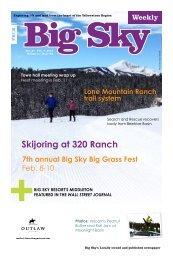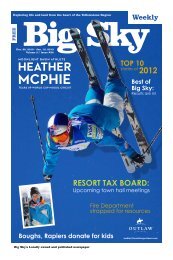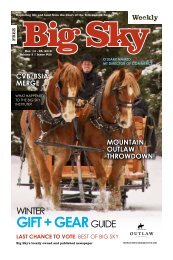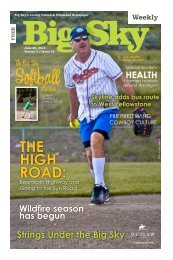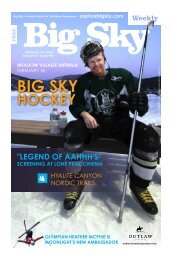health + wellness - Explore Big Sky
health + wellness - Explore Big Sky
health + wellness - Explore Big Sky
You also want an ePaper? Increase the reach of your titles
YUMPU automatically turns print PDFs into web optimized ePapers that Google loves.
summer injury prevention<br />
kayaking and shoulder injuries<br />
by dan benson, dpt<br />
With the massive water runoff,<br />
kayakers are taking advantage of<br />
the raging rivers and giant rapids.<br />
Although these amazing river<br />
conditions allow for phenomenal<br />
paddling, they are the basis for an<br />
increased number of injuries.<br />
Given the lack of surface area to<br />
create a stable joint, it’s not surprising<br />
the shoulders are kayakers’ most<br />
frequently injured body part. Ideal<br />
shoulder mechanics while sitting<br />
are a sequence of hip, thoracic spine<br />
(upper back), scapula (shoulder<br />
blade), and arm movement patterns.<br />
Technique is vital to a kayaker’s injury<br />
prevention but cannot be fully realized<br />
unless there exists a freedom<br />
of movement in the joint, combined<br />
with stability.<br />
A stable kayaking foundation is<br />
derived from a solid sitting position.<br />
If the hamstrings and posterior hip<br />
capsules are too tight, it’s impossible<br />
to maintain a straight low back<br />
alignment while sitting. Poor posture<br />
leads to decreased spinal motion and<br />
increased stress in the shoulders.<br />
injury Prevention exercises<br />
hamstring stretch:<br />
Stand and place your foot on a chair or step. Bend the knee of the elevated leg<br />
slightly and tilt forward at your pelvis (so your low back remains straight) until<br />
your hamstrings stretch. Turn your foot side to side 10-20 times to move the<br />
stretch around.<br />
thoracic spine stretch:<br />
Sit with knees pelvis high and feet flat on the floor (straight back). Hold your<br />
arms in front of you and, with increasing momentum, rotate side to side. Rotate<br />
each direction 10-20 times.<br />
photo by ryan van lenninG<br />
Try slouching in your chair and see<br />
how far you can rotate your spine to<br />
reach behind you. Re-try the same<br />
movement but sit tall with good<br />
posture—the difference in rotation<br />
should be dramatic. The thoracic<br />
spine should be able to move freely<br />
with each paddle stroke and to allow<br />
for correct bracing and rolling<br />
patterns.<br />
The scapula’s job is to guide and<br />
initiate every paddle movement.<br />
For example, when the paddle is<br />
pulling through the water on the<br />
explorebigsky.com<br />
big sky weekly<br />
right, the right shoulder blade<br />
should be squeezing back toward<br />
the spine as the left shoulder blade<br />
glides forward in preparation for its<br />
upcoming paddle.<br />
Dan Benson is originally from Northern<br />
Michigan and earned his Doctorate<br />
of Physical Therapy from the University<br />
of Vermont. He works for Lone<br />
Peak Physical Therapy and splits his<br />
time between clinics in West Yellowstone<br />
and <strong>Big</strong> <strong>Sky</strong>. Dan has a special<br />
interest in performance enhancement<br />
treatment for athletes of all levels.<br />
Paddling exercise:<br />
Sit with your knees pelvis high and your feet flat on the floor (straight back). Attach<br />
a theraband to one end of your paddle and to the top or bottom of a door and practice<br />
paddling with resistance. Apply the resistance for paddling forward and backward<br />
with your paddle both high and low (keep your hands in front of your torso). Perform<br />
2-3 sets with 10 repetitions in each position. Over exaggerate the thoracic spine<br />
rotation and think about guiding the movements with your shoulder blades.<br />
figure 4 stretch:<br />
Start on your hands and knees and keep your back neutral during this exercise.<br />
Straighten one leg behind you and rotate your other foot forward underneath<br />
you. Reach back with your straight leg—you should feel your other hip stretch.<br />
Move the stretch around by subtly pulsing forward-backward, side-side, and<br />
rotating (10 pulses each).<br />
July 15, 2011 41




